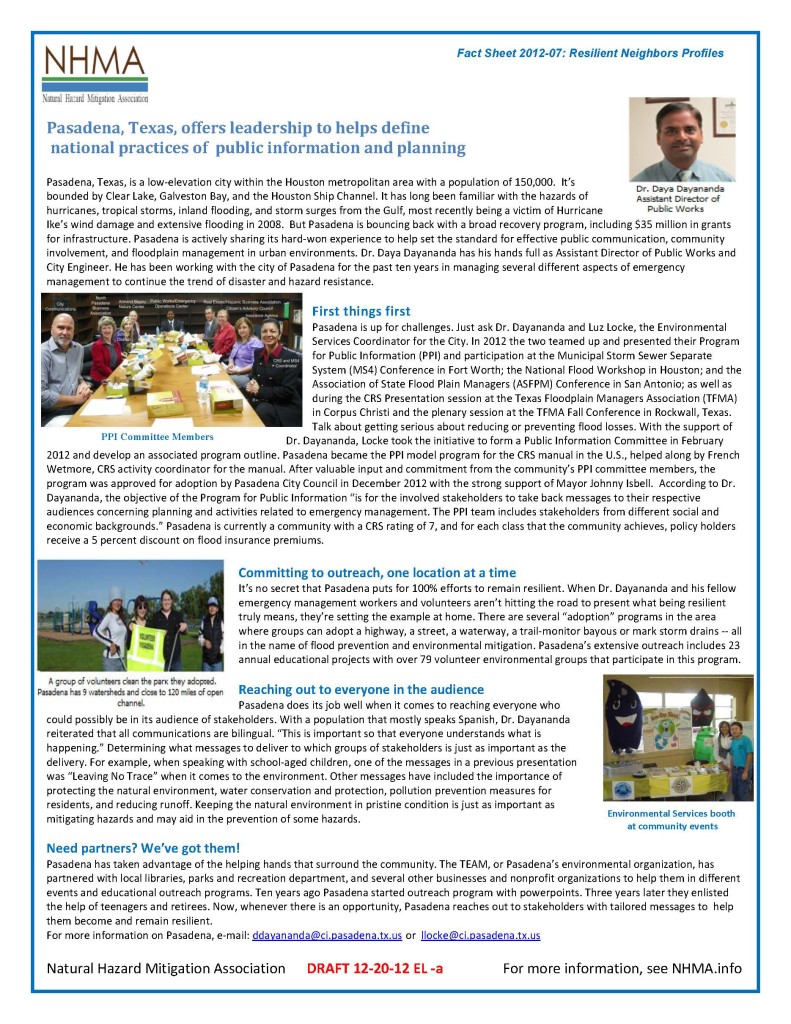To learn more about Pasadena Texas view: Resilient Neighbors Network Community Profiles [pdf] Framework and Profiles
City o f Pasadena Environmental Division TEAM
View Map
Pasadena’s Environmental Division employs public outreach modeling a “rapid response” organization, one uniquely flexible to meet widely varying outreach needs as well as resource limitations. Their TEAM approach enables community education to an extent and level of effectiveness much greater than would be expected of a two-person response effort.
The TEAM approach began as an effort to meet state and federal environmental and flood rating guidelines, with the goal of reducing flood loss of life and property. The problem: How to have these topics rise above the background noise of other messages and impact public awareness in a community that had been less sensitive to this message in the past.
Beginning in 2006, the TEAM began its work with a community-wide Environmental Fair that was the first of its kind, highlighting local government’s encouragement for “green awareness” in the business community. This was followed in later years with Earth Day events, the development of an age-appropriate K – 12th grade curriculum delivered in schools and day care centers, an unprecedented outreach to service and community organizations that had rarely been approached before on environmental issues, and other efforts within the community.
The TEAM approach was to carefully tailor each message specifically to the target audience. Homeowner information prioritized the savings available with better flood ratings for our area and the importance of securing flood insurance even in non-high risk areas. School outreach capitalized on the enthusiasm and volunteerism among youth for environmental improvements. There is no single message the TEAM delivers, preferring instead to emphasize the aspect of their outreach that will best resonate with the audience, be it adult, teen or children.
TEAM communications are constant reminders of the environmental message, be it by in-person appeals, press releases, City publications, fun events or other channels. The TEAM has become a fixture at community events, and the broad range of interests are reflected in their presence at recycling days, hurricane preparedness seminars, library youth fairs, business association meeting and the like.
Challenges in this effort have been significant, as a population that is nearly two-thirds Spanish-language conversant requires translation of much of their materials, and the demographic is low to moderate income, meaning more hands-on contact and less ‘Net based information than would have been possible otherwise.
Extensive use of community volunteers meet many needs that otherwise may not be as quickly addressed due to budget constraints. Individual and group adoption of streets, walking trails, parks and waterways all make significant contributions to quality of life while keeping the tax burden down for the community, while fund raising after Hurricane Ike, featuring a unique Indian Classical Ballet School performance, raised meaningful sums for relief.
Community environmental issues such as storm water control in the past had been addressed chiefly as engineering problems to be solved or enforcement problems to be dealt with. The TEAM approach is to
use a creative, fun and value-based educational program that shows clearly it PAYS to do right by our environment, both in cost savings and quality of life for our community. By developing a network of messengers to spread the word, the old problem of having the City be the sole megaphone from which all environmental pronouncements issue no longer is true. The community understands their pivotal role in reducing environmental pollution, controlling storm water runoff problems and preparing to meet the challenges of living in a region with a long history of flooding. The TEAM uses demonstrations, charts, quick tips…any method that reinforces the fundamental message that all of us have to take responsibility for our community and it physical environment, now and in the future.
The Environmental Division TEAM has taken a topic rarely spoken of except in public works or policing terms and given it a new life as one of the core principals of responsibility for our community. It is the rare City event that is not attended by the TEAM, as is true of many of the larger non-City business gatherings. The importance of TEAM efforts has reached the level where community leaders from education, business, and government enthusiastically accepted a recent invitation to act as an advisory board to the TEAM. The board members will bring environmental concerns of their respective constituencies to the direct attention of the TEAM, to enhance the effectiveness of more timely response to these issues. In return, the board has agreed to act as environmental emissaries in their circle of influence, extending the reach of the environmental message deep into the heart of groups that make significant impacts on the community in greatly differing ways.
The beauty of the TEAM approach is that it has taken a problem everyone was aware of—flooding and the concomitant pollution and damage it causes—and addressed it from the specific perspectives that most effectively marshaled those affected in meeting its challenge.
All of this has been achieved on a budget that was very limited, relying instead on materials that were borrowed from state sources, volunteer efforts, an emphasis on in-person contact, and modest technological investment using off-the-shelf solutions. The program itself can be duplicated by any entity that has a large educational component to their work and an enthusiastic but small group of workers dedicated to developing the most engaging and behavior-altering message possible.
The chief requirement is an understanding that environmental issues are popular and widely supported when presented in a way that emphasizes the value to different community constituents. By making the message ubiquitous, non-threatening and interesting to engage with, small efforts can be leveraged to much greater effect.
Links
- City of Pasadena Official Website
- City of Pasadena Emergency Management
- Nixle Alert Messages
- Resilient City [ppt] 6.2 MB Daya Dayananda PhD, PE, CFM, Assistant Director of Public Works & Environmental Services Manager
- City of Pasadena’s Recovery Plan (Annex J)
